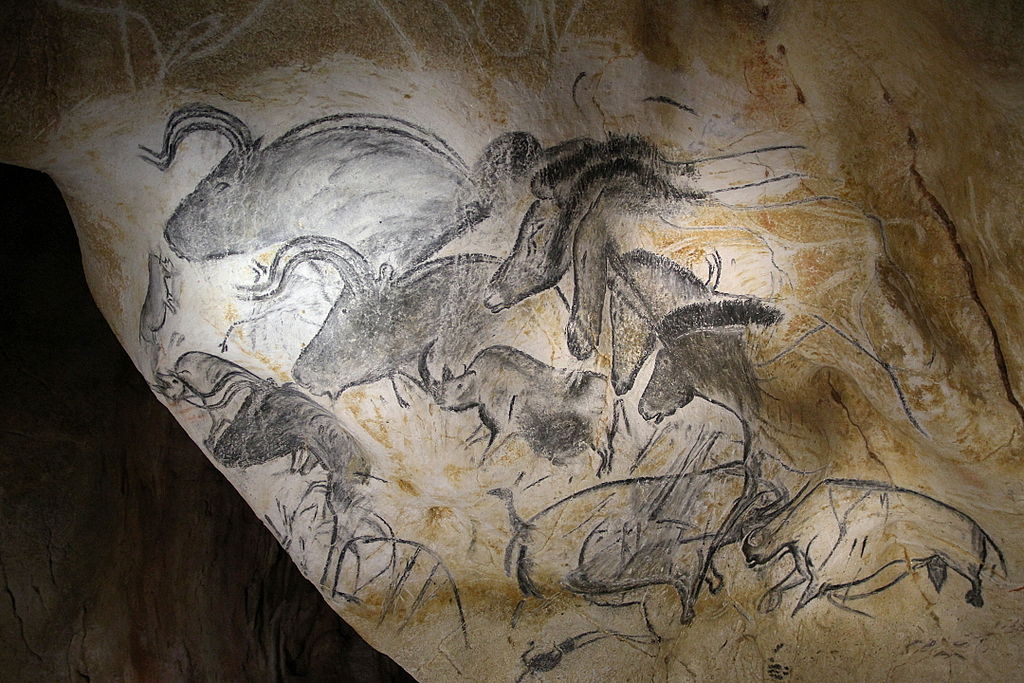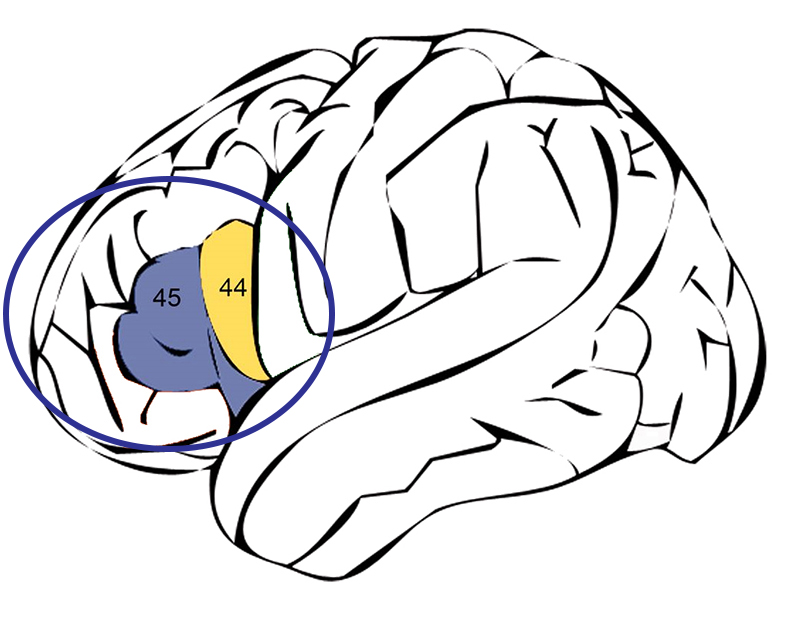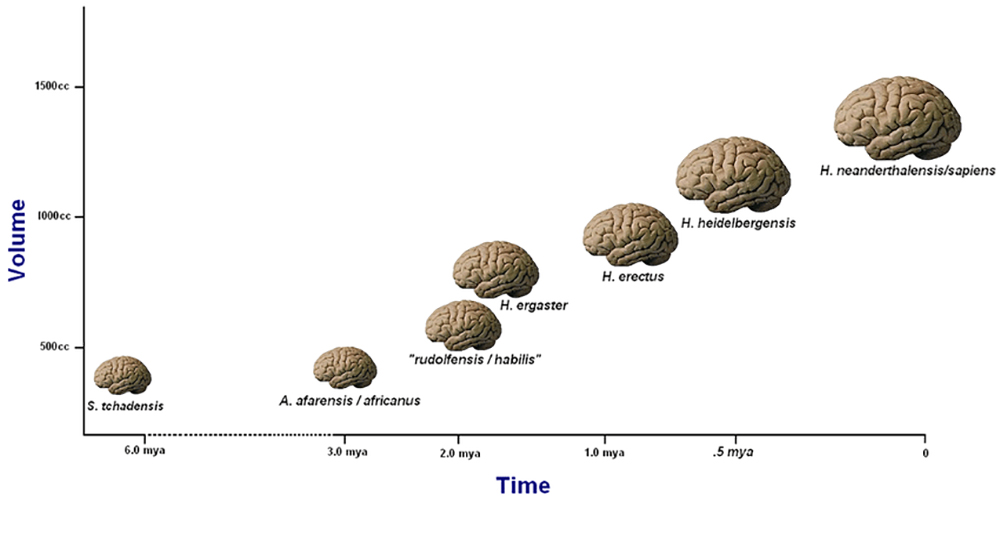4.6 The Genus Homo
Before learning about the hominin species that make up the category genus Homo, it will be helpful to become familiar with the key archaeological time periods with which Homo is associated. The species and cultural developments mentioned below will be explored in greater detail in the sections that follow.
- Lower Paleolithic (from roughly 3 million years ago to approximately 300,000 BCE): This period includes H. habilis and the Oldowan tool industry, followed by H. ergaster and H. erectus and the Acheulean tool industry.
- Middle Paleolithic (approximately 300,000–40,000 BCE): This period includes continued use of Acheulean tools by H. heidelbergensis, followed by H. neanderthalensis and the Mousterian tool industry. Our species, H. sapiens, also emerges during this time.
- Upper Paleolithic (approximately 43,000–26,000 BCE): The Upper Paleolithic saw the emergence of cave art like that found in the famous Chauvet Cave in France, Venus figurines, and an increased use of bone and antler in tools and jewelry. H. neanderthalensis disappears from the fossil record, suggesting their extinction during this time. However, due to mating between species, many H. sapiens carry as much as 4% DNA from H. neanderthalensis.
The most recent ice age occurred during this time, with glaciers covering huge parts of the planet. The emergence of Paleoindians and the use of Clovis points, which were used to kill large game such as mastodons and mammoths, occurred near the end of this time period. - Neolithic (Agricultural Age) (8,000–3,000 BCE): New innovations appear during the agricultural age, or “Neolithic revolution,” as H. sapiens set up permanent settlements. Humans begin to transition from being hunters and gatherers to growing grow crops, owning land, and domesticating animals.

Physiological Changes
A key characteristic shared of the genus Homo is bipedalism. The transition to bipedalism is linked with various anatomical changes, including longer legs, changes in spinal curvature, and the development of arches in the feet to conserve energy and increase balance when walking.
What criteria other than bipedalism might be used to classify a species under the genus Homo? Many anthropologists have attempted to establish specific criteria to use in determining a classification of Homo. Paleoanthropologists Mary Leakey (1913-1996), Louis Leakey (1903-1972), and John Napier (1917-1987), as well as primatologist Phillip Tobias (1925-2012), were among the first to extensively study the fossils of Homo habilis, considered to be one of the earliest species in the genus Homo. H. habilis had a brain size of around 661–700 cc, which was larger than the australopithecines’, with hands that were capable of the dexterity needed for making tools, due to bone structure changes and a repositioning of the thumb, which allowed for better grip.
Based on an endocranial cast, it was determined that H. habilis may have possessed what is called a Broca’s area in the brain. Broca’s area, which includes two Brodmann areas (referred to as 44 and 45), is located in the middle of the left cerebral cortex of the brain and is especially important for speech development (Figure 4.5). Some scientists have suggested that H. habilis started to develop the neural networks necessary for human speech, while others argue that H. habilis probably already had speech.

One of the main considerations in classifying H. habilis as a Homo and not an Australopithecus was its cranial capacity, which is a measurement that indicates brain size. With some exceptions, cranial capacity can serve as an indicator of where a hominin fossil might belong in the hominin phylogenetic tree. Encephalization refers to a progressive increase in brain size over time. In human evolution, we can observe encephalization beginning with H. habilis and progressing more rapidly through H. erectus. Encephalization correlates with an increase in behavioral, cognitive, and cultural complexity. Cognitive developments correspond with our ability to construct and form ideas, including the ability think in and communicate via symbolic and abstract language, such as that used in storytelling, ritual, and art.
The encephalization quotient (EQ) can serve as a good indicator (with some exceptions) of classification within the genus Homo. The encephalization quotient is a calculation arrived at by comparing the ratio between actual brain size (determined with either a mass or volume calculation) and expected brain size. Body size is a factor in these measurements as expected brain size reflects the relationship between brain and body size for a given taxonomic group. The larger the brain weight relative to the overall body weight, the more likely that the brain was used for more complex cognitive tasks. In his book, Evolution of the Brain and Intelligence, Harry J. Jerison (1973) was the first to develop EQ measurements. While EQ is a strong tool for studying brain size in early hominins, there are always potential margins of error when dealing with fragmentary fossils, and increasingly alternative forms of measurements are being proposed. One study proposes that EQ should no longer be used as a tool in calculating brain size in primates and other vertebrate species, based on the premise that cognitive performance does not depend on body size and so body size should not be included in the formula (Schaik et al. 2021). Other theories consider the number of cortical neurons and neural connections as most important when considering cognitive ability (Dicke and Roth 2016). According to this approach, the number of neural connections in the cortex more associated with intelligence than is brain size. Other interesting research is looking at potential levels of cognition and memory as it relates to levels of tool complexity (Read and van der Leeuw 2008).
In spite of these criticisms, many see EQ measurements as providing fairly consistent results. Modern humans (Homo sapiens) have an EQ of roughly 6.0–7.0 (meaning that their brain mass is six to seven times greater than what one would expect to find in a comparable mammal of the same body size). H. erectus has an EQ of 4.0. Figure 4.6 shows increases in average brain sizes for various species over time.

a form of locomotion using two limbs; walking upright.
an imprint of the interior of the brain case.
the area of the brain that regulates breathing patterns while speaking and vocalizations required for normal speech.
the volume of the interior of the cranium of vertebrates that possess a cranium and a brain
a concept that implies an increase in brain or neocortex size relative to body size, size of lower brain areas, and/or evolutionary time.
a measure of relative brain size defined as the ratio between actual brain mass and predicted brain mass for an animal of a given size, which is hypothesized to be a rough estimate of the intelligence of the animal.
the outer layer of the cerebrum (the cerebral cortex ), composed of folded gray matter and playing an important role in consciousness.

